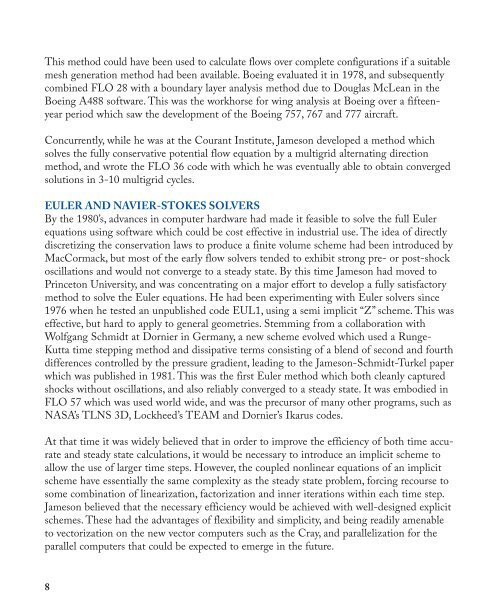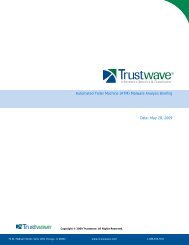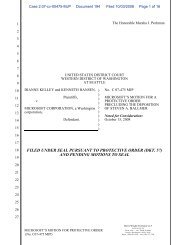The Elmer A. Sperry Award 2006
The Elmer A. Sperry Award 2006
The Elmer A. Sperry Award 2006
You also want an ePaper? Increase the reach of your titles
YUMPU automatically turns print PDFs into web optimized ePapers that Google loves.
This method could have been used to calculate flows over complete configurations if a suitable<br />
mesh generation method had been available. Boeing evaluated it in 1978, and subsequently<br />
combined FLO 28 with a boundary layer analysis method due to Douglas McLean in the<br />
Boeing A488 software. This was the workhorse for wing analysis at Boeing over a fifteenyear<br />
period which saw the development of the Boeing 757, 767 and 777 aircraft.<br />
Concurrently, while he was at the Courant Institute, Jameson developed a method which<br />
solves the fully conservative potential flow equation by a multigrid alternating direction<br />
method, and wrote the FLO 36 code with which he was eventually able to obtain converged<br />
solutions in 3-10 multigrid cycles.<br />
EULER AND NAVIER-STOKES SOLVERS<br />
By the 1980’s, advances in computer hardware had made it feasible to solve the full Euler<br />
equations using software which could be cost effective in industrial use. <strong>The</strong> idea of directly<br />
discretizing the conservation laws to produce a finite volume scheme had been introduced by<br />
MacCormack, but most of the early flow solvers tended to exhibit strong pre- or post-shock<br />
oscillations and would not converge to a steady state. By this time Jameson had moved to<br />
Princeton University, and was concentrating on a major effort to develop a fully satisfactory<br />
method to solve the Euler equations. He had been experimenting with Euler solvers since<br />
1976 when he tested an unpublished code EUL1, using a semi implicit “Z” scheme. This was<br />
effective, but hard to apply to general geometries. Stemming from a collaboration with<br />
Wolfgang Schmidt at Dornier in Germany, a new scheme evolved which used a Runge-<br />
Kutta time stepping method and dissipative terms consisting of a blend of second and fourth<br />
differences controlled by the pressure gradient, leading to the Jameson-Schmidt-Turkel paper<br />
which was published in 1981. This was the first Euler method which both cleanly captured<br />
shocks without oscillations, and also reliably converged to a steady state. It was embodied in<br />
FLO 57 which was used world wide, and was the precursor of many other programs, such as<br />
NASA’s TLNS 3D, Lockheed’s TEAM and Dornier’s Ikarus codes.<br />
At that time it was widely believed that in order to improve the efficiency of both time accurate<br />
and steady state calculations, it would be necessary to introduce an implicit scheme to<br />
allow the use of larger time steps. However, the coupled nonlinear equations of an implicit<br />
scheme have essentially the same complexity as the steady state problem, forcing recourse to<br />
some combination of linearization, factorization and inner iterations within each time step.<br />
Jameson believed that the necessary efficiency would be achieved with well-designed explicit<br />
schemes. <strong>The</strong>se had the advantages of flexibility and simplicity, and being readily amenable<br />
to vectorization on the new vector computers such as the Cray, and parallelization for the<br />
parallel computers that could be expected to emerge in the future.<br />
8






